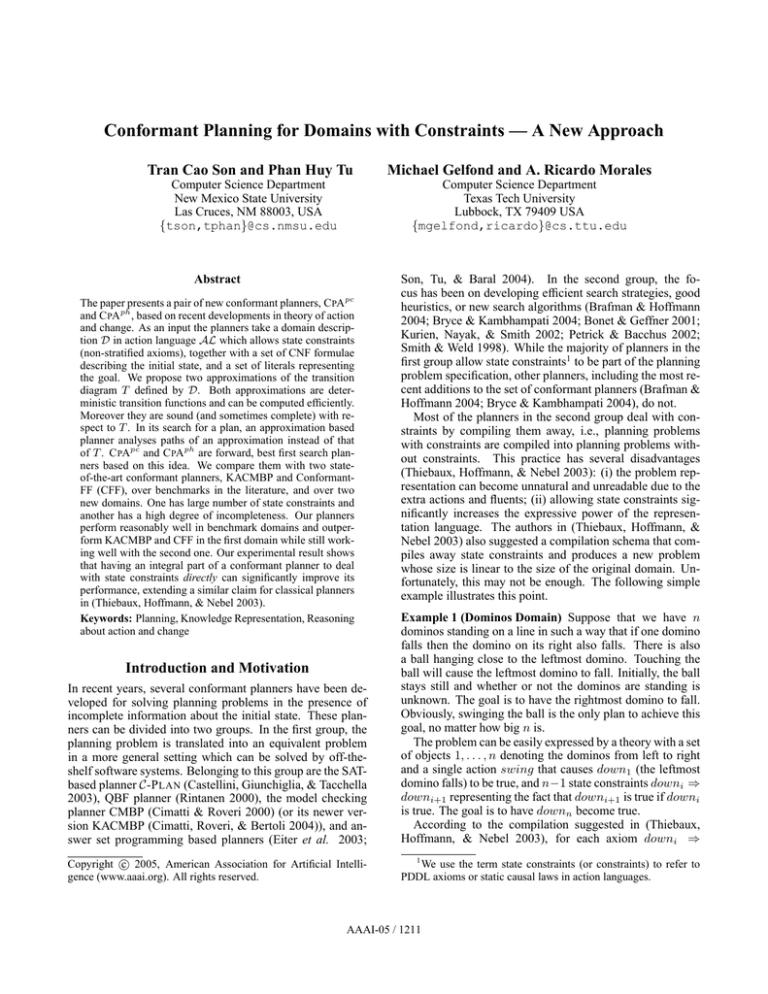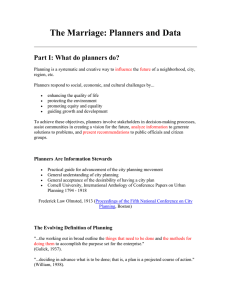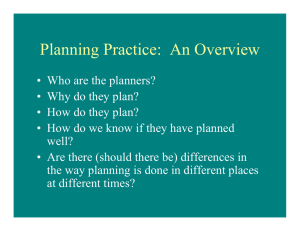
Conformant Planning for Domains with Constraints — A New Approach
Tran Cao Son and Phan Huy Tu
Michael Gelfond and A. Ricardo Morales
Computer Science Department
New Mexico State University
Las Cruces, NM 88003, USA
{tson,tphan}@cs.nmsu.edu
Computer Science Department
Texas Tech University
Lubbock, TX 79409 USA
{mgelfond,ricardo}@cs.ttu.edu
Abstract
The paper presents a pair of new conformant planners, C PApc
and C PAph , based on recent developments in theory of action
and change. As an input the planners take a domain description D in action language AL which allows state constraints
(non-stratified axioms), together with a set of CNF formulae
describing the initial state, and a set of literals representing
the goal. We propose two approximations of the transition
diagram T defined by D. Both approximations are deterministic transition functions and can be computed efficiently.
Moreover they are sound (and sometimes complete) with respect to T . In its search for a plan, an approximation based
planner analyses paths of an approximation instead of that
of T . C PApc and C PAph are forward, best first search planners based on this idea. We compare them with two stateof-the-art conformant planners, KACMBP and ConformantFF (CFF), over benchmarks in the literature, and over two
new domains. One has large number of state constraints and
another has a high degree of incompleteness. Our planners
perform reasonably well in benchmark domains and outperform KACMBP and CFF in the first domain while still working well with the second one. Our experimental result shows
that having an integral part of a conformant planner to deal
with state constraints directly can significantly improve its
performance, extending a similar claim for classical planners
in (Thiebaux, Hoffmann, & Nebel 2003).
Keywords: Planning, Knowledge Representation, Reasoning
about action and change
Son, Tu, & Baral 2004). In the second group, the focus has been on developing efficient search strategies, good
heuristics, or new search algorithms (Brafman & Hoffmann
2004; Bryce & Kambhampati 2004; Bonet & Geffner 2001;
Kurien, Nayak, & Smith 2002; Petrick & Bacchus 2002;
Smith & Weld 1998). While the majority of planners in the
first group allow state constraints1 to be part of the planning
problem specification, other planners, including the most recent additions to the set of conformant planners (Brafman &
Hoffmann 2004; Bryce & Kambhampati 2004), do not.
Most of the planners in the second group deal with constraints by compiling them away, i.e., planning problems
with constraints are compiled into planning problems without constraints. This practice has several disadvantages
(Thiebaux, Hoffmann, & Nebel 2003): (i) the problem representation can become unnatural and unreadable due to the
extra actions and fluents; (ii) allowing state constraints significantly increases the expressive power of the representation language. The authors in (Thiebaux, Hoffmann, &
Nebel 2003) also suggested a compilation schema that compiles away state constraints and produces a new problem
whose size is linear to the size of the original domain. Unfortunately, this may not be enough. The following simple
example illustrates this point.
In recent years, several conformant planners have been developed for solving planning problems in the presence of
incomplete information about the initial state. These planners can be divided into two groups. In the first group, the
planning problem is translated into an equivalent problem
in a more general setting which can be solved by off-theshelf software systems. Belonging to this group are the SATbased planner C-P LAN (Castellini, Giunchiglia, & Tacchella
2003), QBF planner (Rintanen 2000), the model checking
planner CMBP (Cimatti & Roveri 2000) (or its newer version KACMBP (Cimatti, Roveri, & Bertoli 2004)), and answer set programming based planners (Eiter et al. 2003;
Example 1 (Dominos Domain) Suppose that we have n
dominos standing on a line in such a way that if one domino
falls then the domino on its right also falls. There is also
a ball hanging close to the leftmost domino. Touching the
ball will cause the leftmost domino to fall. Initially, the ball
stays still and whether or not the dominos are standing is
unknown. The goal is to have the rightmost domino to fall.
Obviously, swinging the ball is the only plan to achieve this
goal, no matter how big n is.
The problem can be easily expressed by a theory with a set
of objects 1, . . . , n denoting the dominos from left to right
and a single action swing that causes down1 (the leftmost
domino falls) to be true, and n−1 state constraints downi ⇒
downi+1 representing the fact that downi+1 is true if downi
is true. The goal is to have downn become true.
According to the compilation suggested in (Thiebaux,
Hoffmann, & Nebel 2003), for each axiom downi ⇒
c 2005, American Association for Artificial IntelliCopyright °
gence (www.aaai.org). All rights reserved.
1
We use the term state constraints (or constraints) to refer to
PDDL axioms or static causal laws in action languages.
Introduction and Motivation
AAAI-05 / 1211
downi+1 , we introduce a new action ei whose effect is
downi+1 and whose precondition is downi . Clearly, under
this compilation, the plan to achieve the goal is the sequence
of actions [swing, e1 , . . . , en−1 ].
The main problem with this compilation is that the plan
length increases with the number of objects. Even when it
is only linear to the size of the original problem, it proves
to be challenging for planners following this approach. We
tested this simple problem with some of the state-of-the-art
planners that do not support state constraints. Most returned
no solution after 30 minutes when n>500.
2
In this paper we present a pair of new conformant planners based on recent developments in theory of action and
change. As an input such planners take a domain description D in action language AL which allows state constraints,
together with a set of CNF formulae describing the initial
situation, and a set of literals representing the goal. In our
implementation, the latter two are translated into a set of
initial partial states and a goal partial state correspondingly.
The planners’ search spaces are defined by two transition diagrams whose nodes are sets of partial states, called approximations of the transition diagram T of D. These proposed
approximations have two important properties: (i) they are
deterministic and their transition functions can be computed
efficiently, (ii) conformant plans can be found by analyzing paths of the corresponding approximation. Futhermore,
if the set of initial partial states is singleton then this reduces the complexity of the conformant planning problem
to NP-complete, comparing to Σ2P -complete (Turner 2002).
Although approximation based planners are in general incomplete, our planners are powerful enough to solve all literature benchmarks used in our experiment. Given that the
underlying heuristic functions do sometime stumble in certain domains, we view the theoretical incompleteness as a
reasonable price for gaining efficiency.
To summarize, the main contributions of the paper are:
• two sound approximations for reasoning about actions
and their effects in the presence of axioms and incomplete information about the initial situation. To the best
of our knowledge, such approximations have been developed only for theories with incomplete information about
the initial state and sensing actions that do not contain
axioms (Son & Baral 2001). In a recent paper, an approximation has been developed but only for very limited class
of theories (Gelfond & Morales 2004).
• two conformant planners whose performance is comparable with state-of-the-art conformant planners in several
domains. The key component of the planner is the module
for computing the approximations.
• two new domains for testing conformant planners; the
domino domain (Exp. 1) is rich with constraints and the
cleaner domain (later) has a high degree of incompleteness in the initial state; these domains seem to be difficult
for current state-of-the-art conformant planners.
Background
We begin with a short review of the basic definitions of the
language AL from (Baral & Gelfond 2000) and a fixpoint
characterization for domains with state constraints. The alphabet of a domain consists of a set of action names A and
a set of fluent names F. A (fluent) literal is either a fluent
f ∈ F or its negation ¬f . A domain description (or a domain) D is a set of laws of the following forms:
a causes l if ψ
l if ψ
impossible a if ψ
(1)
(2)
(3)
where a ∈ A is an action, l is a fluent literal, and ψ is a set
of literals. (1) is called a dynamic causal law, describing the
explicit effect of action a. It says that if a is performed in
a state wherein ψ holds then l will hold in every successor
state. (2), called a state constraint, says that in any state in
which ψ holds, then so does l. (3) is called an impossibility
law which states that a cannot be executed when ψ holds.
Given a domain D, Dd (resp. Ds ) denotes the set of dynamic
causal laws (resp. state constraints in D). Observe that there
is no syntactical restriction on state constraints.
Example 2 The domino domain in Example 1, denoted by
D1 , can be represented by a domain with the dynamic causal
law swing causes down1 and the set of constraints
{downi+1 if downi | 1 ≤ i ≤ n − 1}.
2
We now introduce notations that will be used throughout the
paper. For a fluent f , ¬¬f = f . For a set of literals σ, ¬σ =
{¬l | l ∈ σ}. A literal l (resp. set of literals γ) holds in a
set of literals σ if l ∈ σ (resp. γ ⊆ σ); l (resp. γ) possibly
holds in σ if ¬l 6∈ σ (resp. ¬γ ∩ σ = ∅). A set of literals
σ satisfies a constraint (2) if it holds that ψ ⊆ σ implies
l ∈ σ. σ is closed under Ds if it satisfies every r ∈ Ds . By
ClD (σ), we denote the smallest set of literals that contains
σ and is closed under Ds . An interpretation I of F is a set
of literals such that for every f ∈ F, {f, ¬f } ∩ I 6= ∅ and
{f, ¬f }\I 6= ∅. A state of D is an interpretation of F closed
under Ds . An action a is executable in s if there exists no
dynamic causal law (3) such that ψ holds in s.
Given a domain D, for an action a and a state s such that
a is executable in s, let e(a, s) = {l | a causes l if ψ ∈
Dd , ψ ⊆ s}. In essence, e(a, s) denotes the direct effects
of a. We define the set of possible successor states after
executing a in s, denoted by RescD (a, s), as follows.
Definition 1 ((McCain & Turner 95)) Let D be a domain
description and a be an action that is executable in a state
s. A state s0 is called a possible successor of s after the
execution of a if s0 = ClD (e(a, s) ∪ (s ∩ s0 )).
The set of possible successors of s after the execution of a
is denoted by RescD (a, s).
As an example, the state s0 = {¬downi | 1 ≤ i ≤ n}
represents the fact that all dominos are standing. Furthermore, e(swing, s0 ) = {down1 } and RescD1 (swing, s0 ) =
{{downi | 1 ≤ i ≤ n}}.
We say that a domain is inconsistent if RescD (a, s) = ∅
for some action a and state s such that a is executable in s.
In the rest of the paper, we are only interested in consistent
domains. Intuitively, Definition 1 says that if the agent is
currently in state s then after executing a it will reach one of
AAAI-05 / 1212
the states in RescD (a, s). In the presence of incomplete information, the agent does not always know what exact state
it is currently in. It might need to consider a set W of possible states rather than a single one. In this case, the set of
possible successor states, RescD (a, W), is defined as
• RescD (a, W) = ∅Sif RescD (a, s) = ∅ for some s ∈ W;
• RescD (a, W) = s∈W RescD (a, s), otherwise.
The set of states reached after executing an action sequence
α = ha1 ; . . . ; an i from a set of states W is defined next.
½
RescD (α, W) =
W if n = 0
RescD (a2 ; . . . ; an , RescD (a1 , W)) if n ≥ 1
We say that a literal l holds after the execution of α in W,
denoted by (D, W) |= l after α, if RescD (α, W) 6= ∅ and
l ∈ s for every state s ∈ RescD (α, W).
By a partial state of D we mean a consistent collection
of fluent literals closed under Ds . Partial states are denoted
by (possibly indexed) Greek letters. A state s containing a
partial state δ is called a completion of δ. By ext(δ) we
denote the set of all completions of δ. For a set of partial
states ∆, let ext(∆) = ∪δ∈∆ ext(δ).
Let D be a domain description, ∆0 be a set of partial
states, and δ f be a partial state. We say that a sequence
of actions α is a conformant plan achieving δ f from ∆0 if
(D, ext(∆0 )) |= l after α for every l ∈ δ f . We define:
Definition 2 Given a domain description D, a set of partial
states ∆0 , a parial state δ f . The conformant planning problem is the problem of computing a tractable conformant plan
achieving the goal δ f from ∆0 .
The 1-conformant planning problem is the conformant
planning problem restricted to the case where |∆0 | = 1.
Abusing the notation, we often refer to hD, ∆0 , δ f i as a
planning problem whenever there is no confusion possible.
Two Approximations of RescD
Given a conformant planning problem, most of search-based
planners look for solutions by exploring the belief state2
space whose size is double exponential in the number of
fluents. Adding to this, determining what is true/false after
one action is executed in the presence of incomplete information is a co-NP complete problem even when state constraints are not present (Baral, Kreinovich, & Trejo 2000).
As such, we begin our quest for building a conformant planner by looking for ways to reduce the complexity of the task.
We achieve this goal by developing two sound (but incomplete) approximations of the function RescD which we depc
note by Resph
D and ResD (ph and pc stand for “possibly
holds” and “possibly changes”, respectively). We sometime
write ResaD whenever we would like to refer to either Resph
D
and/or Respc
D . Each approximation is a function that maps
pairs of partial states and actions into partial states. Both are
deterministic and can be computed efficiently. Moreover,
both reduce the size of the state space to single exponential
to the number of fluents.
Given an action a and a partial state δ, we will now define
ResaD (a, δ), an approximation of what will hold after the
2
A belief state is a set of states.
execution of a in δ. Before presenting the formulae defining ResaD , let us observe that each possible successor state
s0 in Definition 1 can be divided into three parts: (i) e(a, s)
contains the direct effects of a; (ii) s ∩ s0 contains what remains unchanged (because of the inertial law); and (iii) the
set of the indirect effects of a. Any formulation of the ResaD
should account for these three components.
To specify the direct effects of an action we take the view
of a skeptical reasoner. Given a partial state δ and an action
a, we define e(a, δ) = {l | a causes l if ψ ∈ Dd , and ψ ⊆
δ} and mc(a, δ) = {l | a causes l if ψ ∈ Dd , and ¬ψ ∩ δ =
∅}. Intuitively, e(a, δ) (resp. mc(a, δ)) consists of the direct
effects (reps. possible direct effects) of a when it is executed
in a state in which δ holds. As an example, for the action
swing in D1 , we have that e(swing, δ) = mc(swing, δ) =
{down1 } for every δ.
The main difficulty in characterizing ResaD , however, lies
in specifying the second component, i.e., what remains unchanged by the inertial law. Different ways of defining this
set lead to different approximations of RescD . We next introduce two possibilities.
Approximation Based on What Possibly Holds
c
We will now define Resph
D which approximates ResD based
on what possibly holds. Here, we view the inertial part as a
set of literals whose negations cannot possibly hold. Given
an action a and a partial state δ such that a is executable in
δ, a literal l possibly holds in a successor state, say δ 0 , if one
of the following happens.
• a might cause l to hold, i.e., l ∈ mc(a, δ);
• ¬l does not hold in δ and there exists no dynamic causal
law (1) s.t. ψ holds in δ, i.e., ¬l 6∈ (δ ∪ e(a, δ));
• there exists a constraint (2) s.t. ψ possibly holds in δ 0 .
Resph
D (a, δ) conservatively defines the second component as the set of all literals whose negations
cannot possibly hold.
Formally, let ph(a, δ) =
ClD (mc(a, δ) ∪ {l | ¬l 6∈ (δ ∪ e(a, δ))}), we define
Resph
D (a, δ) = ClD (e(a, δ) ∪ {l | l 6∈ ¬ph(a, δ)})
if ClD (e(a, δ) ∪ {l | l 6∈ ¬ph(a, δ)}) is consistent; otherwise, Resph
D (a, δ) = ⊥. We will discuss some properties of
ph
ResD after the definition of the second approximation.
Approximation Based on What Possibly Changes
While Resph
D approximates the inertial part by looking at
what might hold in the successor partial state, Respc
D looks at
what might change. It resembles RescD by assuming that the
result is known, say δ 0 . That is, assume that Respc
D (a, δ) =
δ 0 . We say that a literal l is possibly changed after the execution of a in δ if it does not belong to δ but possibly
holds in δ 0 . We denote the set of possibly changed literals
by pc(a, δ, δ 0 ). Observe that a literal l possibly changes its
value if l 6∈ δ and
• a might directly cause l, i.e., l ∈ mc(a, δ); or
• there exists a constraint (2) s.t. ψ possibly holds in δ 0 and
contains at least one literal that possibly changes.
i
0
This leads us to define pc(a, δ, δ 0 ) = ∪∞
i=0 pc (a, δ, δ ) where
pc0 (a, δ, δ 0 ) = mc(a, δ) \ δ,
pci+1 (a, δ, δ 0 ) = (pci (a, δ, δ 0 ) ∪ Ωi ) \ δ for i ≥ 0 with
AAAI-05 / 1213
Ωi ={l | l if ψ ∈ Ds , ¬ψ ∩ δ 0 =∅, and ψ ∩ pci (a, δ, δ 0 )6=∅}.
The definition of Respc
D rests on the following observations: (i) δ 0 must contain ClD (e(a, δ)); (ii) ClD (δ 0 ∪
(δ \ ¬pc(a, δ, δ 0 ))) holds in every succesor state resulting from executing a in a state satisfying δ; and
(iii) for the sequence of partial states δ1 , δ2 , . . . where
δ1 =ClD (e(a, δ)), and δi+1 =ClD (δi ∪ (δ \ ¬pc(a, δ, δi )))
for i≥1, it holds that (a) δi ⊆ δi+1 ; and (b) δi holds
in every successor state resulting from executing a in
a state satisfying δ; and (c) this sequence converges to
a partial state δ ∗ . We therefore define Respc (a, δ) as
∗
Respc
D (a, δ) = δ
∗
if δ is consistent; and Respc
(a,
δ)
=
⊥ otherwise. We will
D
now discuss some properties of the approximations.
Properties of the Approximations
Notice that in the definitions of ResaD , we take into account
the three components mentioned earlier: (i) the direct effect
of a: e(a, δ); (ii) the inertial part: {l | l 6∈ ¬ph(a, δ)} or
δ \ ¬pc(a, δ, δ 0 ) (iii) the indirect effect of a: those generated
by the operator ClD . It is easy to see that ResaD (a, δ) is
uniquely defined, i.e., the functions Resa are deterministic.
The definitions of RescD (a, W) and |= are extended to
define ResaD (a, ∆) and |=a in a straightforward way. We
omit them here to save space.
Example 3 Consider the following domain description D2
defined over the set of fluents {f, g, h, k, p, q}.
a causes f
g if f, ¬h
a causes g if k
k if f
g if f, h
p if g, q
Suppose that we perform a in ∆ = {δ}, where δ = {¬f ,
¬g, ¬p, ¬q}. Intuitively, we would expect that afterward f
should be true (as a direct effect of a); k and g should be true
(because of “k if f ”, and “g if f, h” and “g if f, ¬h”
respectively); and p, q should be false (because of inertia).
We have that e(a, δ) = {f } and mc(a, δ) = {f, g}.
X = δ ∪ e(a, δ) = {¬f, ¬g, ¬p, ¬q, f }
Y = {l | ¬l6∈X} = {¬g, ¬p, ¬q, h, ¬h, k, ¬k}
Z = mc(a, δ)∪Y = {f, g, ¬g, ¬p, ¬q, h, ¬h, k, ¬k}
ph(a, δ)=ClD2 (Z)={f, g, ¬g, ¬p, ¬q, h, ¬h, k, ¬k}
Hence, Resph
D2 (a, δ) = {f, ¬p, ¬q, k}.
For Respc , δ1 = ClD2 (e(a, δ)) = {f, k} and
pc0 (a, δ, δ1 ) = {f, g}, Ω0 = {k, g, p}
pci (a, δ, δ1 ) = {f, g, k, p}, Ωi = {k, g, p} for i ≥ 1.
This leads to δ2 = {f, k, ¬q}. Repeating this computation
with δ2 , we get δ3 =δ2 . So, Respc
D2 (a, δ)={f, k, ¬q}.
As a result, we have Respc (a, ∆) = {{f, k, ¬q}} and
Resph
D2 (a, ∆) = {{f, ¬p, ¬q, k}}.
pc
Observe that both Resph
D2 (a, ∆) and ResD2 (a, ∆) draw
f, k, ¬q as expected; furthermore, the former can draw ¬p,
whereas the latter cannot. But none of them could draw g.
Nevertheless, if ∆ was {δ ∪ {h}, δ ∪ {¬h}}, then both could
draw g. Some other entailments w.r.t. the approximation
semantics are: (D2 , ∆)|=a f after a; (D2 , ∆)6|=a g after a;
(D2 , ∆)6|=a ¬g after a.
2
We now show some properties of the approximations. The
next theorem shows that |=a is sound w.r.t. |=.
Theorem 1 (Soundness w.r.t. |=) Let D be a consistent domain description, α be a sequence of actions, ∆ be a set of
partial states, and l be a literal. Then,
(D, ∆) |=a l after α implies that (D, ext(∆)) |= l after α.
Example 3 shows that the approximations are not complete
w.r.t. RescD . Apart from this, Respc (a, δ) ⊆ Resph (a, δ).
Our conjecture is that this relationship holds. However, we
have not yet found a formal proof for this property. We also
show that
Theorem 2 Given a domain description D, for any partial
state δ and action a, ResaD (a, δ) can be computed in polynomial time in the size of the domain.
This allows us to prove the following result.
Theorem 3 The 1-conformant planning problem w.r.t. the
approximation semantics is NP-complete.
We have, among other things, extended both approximations to consider concurrent actions and non-deterministic
actions. We also identified a large class of domains in which
|=a is equivalent to |=. These result will be presented in the
complete version of this paper. In the next section, we describe our initial experiments with these approximations in
the development of conformant planners.
Conformant Planning using Approximations
We first implemented an answer set programming based
conformant planner using Resph , which we will refer to
as CPASP. In this sense, CPASP is similar to DLVk (Eiter
et al. 2003), CMBP (Cimatti & Roveri 2000), C-P LAN
(Castellini, Giunchiglia, & Tacchella 2003), QBF (Rintanen
2000). CPASP allows parallel actions. We tested CPASP
against DLVk , CMBP, and C-P LAN because these planners
do allow state constraints and are similar in spirit of CPASP.
Our results show that CPASP is competitive with these planners in most of the domains from the literature. Due to space
limit, we omit here the detailed encoding of CPASP and the
experimental result. The main weakness of CPASP is that it
does not solve problems with disjunctive information about
the initial state. In other words, CPASP can handle only 1conformant planning problems (i.e., for |∆0 | = 1).
To overcome this weakness, we implemented a pair of
planners, called C PApc and C PAph , based on Respc
D and
Resph
respectively,
in
C++.
By
convention,
we
will
write
D
C PA whenever we want to refer to both planners or one of
them when the distinction between them is not important.
C PA employs the best first search strategy with repeated
state avoidance and the number of fulfilled subgoals as the
heuristic function. The main module of C PA is for computing the ResaD function.
C PA accepts problems encoded using the rules of the
forms (1)-(3). The initial state is specified by statements
of the form initially φ (where φ is in the CNF form).
As mentioned ealier, in our implementation, these CNFs
will be translated into a set of initial partial states, e.g.,
the set {initiallyf ∨ g, initially p ∨ q} results in ∆0 =
{ClD ({f, p}), ClD ({f, q}), ClD ({g, p}), ClD ({g, q})}.
The goal is encoded using statements of the form goal φ
where φ is a set of literals.
AAAI-05 / 1214
We compare C PA with three planners CFF, KACMBP,
and POND. These planners were selected for the following reasons. First, CFF and KACMBP are — to the best
of our knowledge — the current fastest conformant planners
in most of the benchmark domains in the literature. Second,
CFF is superior to other state-of-the-art conformant planners
like GPT (Bonet & Geffner 2001), MBP (Cimatti & Roveri
2000) (see (Brafman & Hoffmann 2004)). Third, KACMBP,
a heuristic guided, symbolic model checking based conformant planner supporting state constraints, is known to outperform DLVk and C-P LAN in many domains in the literature (see (Cimatti, Roveri, & Bertoli 2004)); Finally, POND
is a new addition to the set of conformant planners that implemented several interesting heuristics.
We prepare two test-suites. The first one consists of typical conformant planning domains including the Bomb-inthe-toilet (Bomb), the Ring, and Logistics domains. The
first domain was chosen because both CFF and KACMBP
work well with it (e.g. CFF can scale up the Bomb domain
with multiple toilets to 100 packages and 100 toilets within
a minute). The latter two were chosen because the experiments in (Brafman & Hoffmann 2004) showed that CFF
is good at the Logistics problem but not the Ring, while
KACMBP is good at Ring but has poor performance with
Logistics.
In the Bomb domain, we experimented with
10, 20, 50, 100 packages and t = 1, 5, 10 toilets.
The Logistics domain used in our tests is described in
(Brafman & Hoffmann 2004) and distributed together with
the CFF distribution. We did experiments with 5 problems,
corresponding to l = 2, 3, 4 and c = p = 2, 3, where l, c,
and p are the numbers of locations per city, cities, and packages respectively (only Logistics(4,2,2) is not available).
In the Ring domain, one can move in a cyclic fashion (either forward or backward) around a n-room building to lock
windows. Each room has a window and the window can be
locked only if it is closed. The uncertainty is that the initial
state of windows is unknown. The goal is to have all windows locked. A possible conformant plan is to perform a
sequence of actions forward, close, lock repeatedly. In this
domain, we tested with n =2,5,10, and 20.
Three domains in the first test suite, however, do not
contain many state constraints. Most of the constraints in
our encodings are aimed at expressing multivalued variables as boolean fluents3 . To see how good these planners are in dealing with domains rich in constraints, in the
second test suite, we include the Domino domain. We
tested the domain with eight problems corresponding to
n = 10, 50, 200, 100, 500, 1000, 2000, 5000, where n is the
number of dominos. Note that we encoded these problems
for POND and CFF following the compilation procedure in
(Thiebaux, Hoffmann, & Nebel 2003).
The second domain included in the second test suite is the
3
Unlike POND, C PA, and CFF, an advantage of KACMBP
is that it allows multivalued fluents. Thus, it seems to perform
well with numeric domains like Ring, Cube, and Square, etc.
(see (Cimatti, Roveri, & Bertoli 2004) for the performance of
KACMBP over these domains)
Cleaner domain. It is a modified version of the Ring domain.
The difference is that the robot is moving in a linear fashion
rather than in a cyclic fashion and instead of locking the window, the robot has to clean p objects in each room. Initially,
the robot is in the first room and does not know whether
or not objects are cleaned. The goal is to have all objects
cleaned. While the Domino domain exposes a richness in
constraints, the Cleaner domain provides a high degree of
uncertainty in the initial state. We tested the domain with 6
problems corresponding to n = 2, 5 and p = 10, 50, 100.
All experiments were made on a 2.4 GHz CPU, 768MB
RAM machine, running Slackware 10.0 operating system.
Time limit is set to half an hour. The testing results4 for
two test suites are shown in Tables 1–2. Times are shown in
seconds; ‘TO”, “AB”, and “NA” indicate that time limit is
exceeded, that the planner stopped abnormally, and that the
domain is not applicable, respectively.
Domains
KACMBP
CFF
POND
C PApc
C PAph
Bomb(10,1)
Bomb(20,1)
Bomb(50,1)
Bomb(100,1)
Bomb(10,5)
Bomb(20,5)
Bomb(50,5)
Bomb(100,5)
Bomb(10,10)
Bomb(20,10)
Bomb(50,10)
Bomb(100,10)
19 / 0.01
39 / 0.05
99 / 0.51
199 / 3.89
15 / 0.09
35 / 0.30
95 / 1.66
195 / 6.92
10 / 0.30
30 / 0.97
90 / 5.39
190 / 35.83
19 / 0.05
39 / 0.17
99 / 5.33
199 / 121.80
15 / 0.07
35 / 0.16
95 / 4.70
195 / 113.95
10 / 0.05
30 / 0.13
90 / 4.04
190 / 102.56
19/2.61
/AB
/AB
/AB
/AB
/AB
/AB
/AB
/AB
/AB
/AB
/AB
19 / 0.01
39 / 0.06
99 / 0.87
199 / 7.63
15 / 0.03
35 / 0.17
95 / 2.74
195 / 24.17
10 / 0.05
30 / 0.35
90 / 5.34
190 / 43.79
19 / 0.02
39 / 0.13
99 / 1.83
199 / 14.8
15 / 0.07
35 / 0.37
95 / 4.82
195 / 36.90
10 / 0.13
30 / 0.81
90 / 9.470
190 / 65.43
5 / 0.00
14 / 0.00
29 / 0.02
44 / 0.04
59 / 0.15
74 / 0.32
7 / 0.06
45 / 63.67
/ TO
/ TO
/ TO
/ TO
5/0.16
15/39.37
/TO
/TO
/TO
/TO
5 / 0.00
15 / 0.15
30 / 3.25
45 / 21.40
60 / 84.02
75 / 244.02
5 / 0.00
15 / 0.21
30 / 5.03
45 / 34.94
60 / 141.33
75 / 420.20
14 / 0.19
34 / 355.96
17 / 2.10
40 / 29.80
/ TO
16 / 0.03
24 / 0.06
20 / 0.06
34 / 0.12
37 / 0.14
/NA
/NA
/NA
/NA
/NA
12 / 0.75
106 / 120.86
96 / 48.15
/ TO
/ TO
12 / 1.16
106 / 181.95
96 / 74.16
/ TO
/ TO
Ring(2)
Ring(5)
Ring(10)
Ring(15)
Ring(20)
Ring(25)
Logistic(2,2,2)
Logistic(2,3,3)
Logistic(3,2,2)
Logistic(3,3,3)
Logistic(4,3,3)
Table 1: Conformant Planning Benchmarks
As can be seen in Table 1, in the Bomb domain, KACMBP is
the best in general. C PA is competitive with CFF in most of
problems and outperforms CFF in some others. For example, C PApc took 7.63 seconds to solve BMTC(100,1), while
CFF took 121.80 seconds. However, CFF seems to have no
problem when the number of toilets increases, while there is
a significant increase in the amount of time for KACMBP.
The change in the amount of time for C PA is more reasonable than that for KACMBP. For example, with a fixed number of packages 100, when the number of toilets increase
from 5 to 10, the amount of solving time for CFF even decreases, while that for KACMBP about 5 times increases and
C PA’s is just doubled. POND can solve Bomb(10,1) only.
The Ring domain is really problematic for CFF. As explained in (Brafman & Hoffmann 2004), it is because of the
lack of informativity of the heuristic function in the presence
of non-unary effect conditions and the problem with checking repeated states. CFF can solve only the first two problems within the time limit. Again, KACMBP is the best.
C PA is much better than CFF and POND but is not competitive with KACMBP.
4
In each cell, the first number is the length of the solution. The
second number is the time taken by the planner to find the solution.
AAAI-05 / 1215
In the Logistic domain, both KACMBP and C PA had difficulty in finding plans. Although KACMBP is better than
C PA, its performance is far from that of CFF which solved
each problem in less than one second. We believe that the
poor performance of C PA lies in the not-so-good heuristic
function (which is reflected in the plan’s length).
Table 2 shows the testing results for the second test-suite.
As expected, using the mentioned compilation procedure,
CFF has poor performance in the Domino domain. Within
the time limit, KACMBP can only solve problems with
n < 500 but C PA has no problem with n = 5000.
Domains
KACMBP
CFF
POND
C PApc
C PAph
Domino(10)
Domino(50)
Domino(100)
Domino(200)
Domino(500)
Domino(1000)
Domino(2000)
Domino(5000)
23 / 0.01
163 / 0.27
376 / 2.56
852 / 29.10
/ TO
/ TO
/ TO
/ TO
10 / 0.05
50 / 4.44
/ AB
/ AB
/ AB
/ AB
/ AB
/ AB
10/1.72
/TO
/TO
/TO
/TO
/TO
/TO
/TO
1 / 0.00
1 / 0.00
1 / 0.02
1 / 0.06
1 / 0.35
1 / 1.38
1 / 5.38
1 / 36.48
1 / 0.00
1 / 0.01
1 / 0.03
1 / 0.09
1 / 0.59
1 / 2.48
1 / 10.74
1 / 62.68
Cleaner(2,10)
Cleaner(2,20)
Cleaner(2,50)
Cleaner(2,100)
Cleaner(5,10)
Cleaner(5,20)
Cleaner(5,50)
Cleaner(5,100)
21 / 0.08
41 / 0.62
101 / 13.55
201 / 185.39
56 / 0.10
106 / 7.82
256 / 227.82
/ TO
21 / 0.07
41 / 0.15
101 / 0.80
201 / 5.72
54 / 0.24
104 / 0.85
254 / 14.36
/ AB
/AB
/AB
/AB
/AB
/AB
/AB
/AB
/AB
21 / 0.03
41 / 0.13
101 / 1.71
201 / 13.97
54 / 0.41
104 / 2.32
254 / 30.83
504 / 239.08
21 / 0.06
41 / 0.38
101 / 5.39
201 / 44.09
54 / 0.86
104 / 5.52
254 / 85.20
504 / 688.39
Table 2: Domains with Constraints and High Degree of Incompleteness
C PA has a relatively good performance in the Cleaner domain. It can solve Cleaner(5, 100) within the time limit.
The returned plan has 504 actions. CFF is very good at this
domain and outperforms C PA and KACMBP (POND cannot solve any problems of these). Unfortunately, it cannot
solve the last problem since the maximum length of a plan
is exceeded. C PA outperforms KACMBP in most problems
in this domain.
As stated, our planner is sound but not complete, i.e., theoretically speaking, C PA cannot solve some planning problems, even when the initial state is complete. To make sure
our approach can cover a broader spectrum of practical planning problems, we also tested C PA with classical planning
problems. The first domain considered is the Block World
with five problems described in (Eiter et al. 2003). We
then tested with problems in the Rovers domain5 . Five problems, different from each other in the numbers of way points,
rovers, cameras, rock and soil samples, and objectives, were
experimented with. It turns out that C PA can solve all those
problems but did not perform well in the Blocks World domain. We suspect that our heuristic is not good enough to
guide the planner in this domain.
Discussion and Conclusion
We have presented a pair of new conformant planners,
C PApc and C PAph , which deal directly with state constraints. Their performance is comparable with state-of-theart conformant planners over typical benchmark domains as
well as over newly invented domains. Due to the simple
heuristic used in the implementation of C PA, we believe that
the good performance of C PA lies in the use of the approximations. The development of C PA demonstrates that research in reasoning about action and change can positively
5
http://planning.cis.strath.ac.uk/competition/
impact the development of practical planners. Although
C PA yields good performance, there are a number of issues
that need to be investigated. On the implementation side, we
would like to improve C PA’s performance by testing it with
different heuristics used in other planners. We would also
like to find plans with parallel actions and/or minimal plans.
Theoretically, we would like to investigate the relationship
between Resph and Respc and to find a better approximation that allows for limited reasoning by cases for use with
C PA. We also would like to strengthen characteristics of domains in which the approximations are complete6 .
Acknowledgement: The first two authors were partially
supported by NSF grants EIA-0220590 and HRD-0420407.
References
Baral, C.; and Gelfond, M. 2000. Reasoning agents in dynamic
domains. In Minker, J,. ed., LBAI, 257–279.
Baral, C.; Kreinovich, V.; and Trejo, R. 2000. Computational
complexity of planning and approximate planning in the presence
of incompleteness. AIJ 122:241–267.
Bonet, B., and Geffner, H. 2001. GPT: a tool for planning with
uncertainty and partial information. IJCAI-01 Workshop on Planning with Uncertainty and Partial Information, 82–87.
Brafman, R., and Hoffmann, J. 2004. Conformant planning via
heuristic forward search: A new approach. ICAPS-04, 355–364.
Bryce, D., and Kambhampati, S. 2004. Heuristic Guidance Measures for Conformant Planning. ICAPS-04, 365–375.
Castellini, C.; Giunchiglia, E.; and Tacchella, A. 2003. SATbased Planning in Complex Domains: Concurrency, Constraints
and Nondeterminism. AIJ 147:85–117.
Cimatti, A., and Roveri, M. 2000. Conformant Planning via
Symbolic Model Checking. JAIR 13:305–338.
Cimatti, A. et al. 2004. Conformant Planning via Symbolic Model
Checking and Heuristic Search. AIJ 159:127–206.
Eiter, T. et al. 2003. A Logic Programming Approach to Knowledge State Planning, II: The DLVK System. AIJ 144, 157–211.
Gelfond, M., and Morales, R. 2004. Encoding conformant planning in a-prolog. In Proceedings of DRT’04, LNCS.
Kurien, J.; Nayak, P. P.; and Smith, D. E. 2002. Fragment-based
conformant planning. In AIPS, 153–162.
McCain, N., and Turner, H. 95. A causal theory of ramifications
and qualifications. IJCAI, 1978–1984.
Petrick, R., and Bacchus, F. 2002. A knowledge-based approach
to planning with incomplete information and sensing. AIPS-02,
212–222.
Rintanen, J. 2000. Constructing conditional plans by a theorem
prover. JAIR 10:323–352.
Smith, D. & Weld, D. 1998. Conformant Graphplan. AAAI.
Son, T., and Baral, C. 2001. Formalizing sensing actions - a
transition function based approach. AIJ 125(1-2):19–91.
Son, T. et al. 2004. Planning with Sensing Actions and Incomplete Information using Logic Programming. LPNMR, 261–274.
Thiebaux, S.; Hoffmann, J.; and Nebel, B. 2003. In Defense of
PDDL Axioms. IJCAI’03.
Turner, H. 2002. Polynomial-length planning spans the polynomial hierarchy. JELIA’02, 111–124.
6
It is worth noting that the current characteristics seem to cover
most problems found in the literature. This result will be available
in the complete version of this paper.
AAAI-05 / 1216










